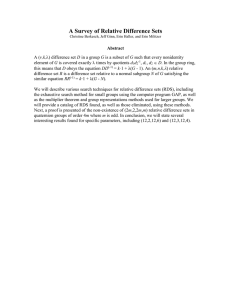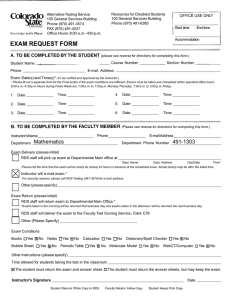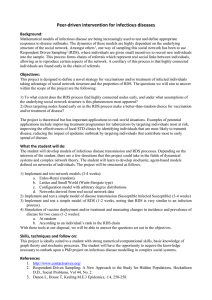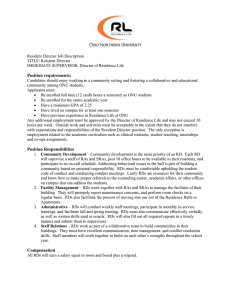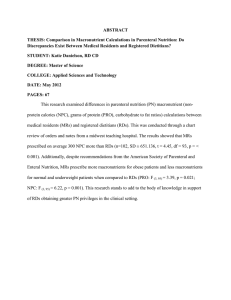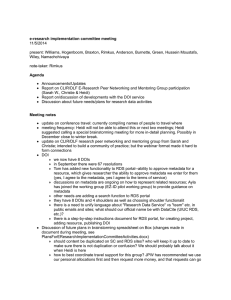A Survey of Relative Difference Sets Christine Berkesch Jeff Ginn Erin Haller
advertisement
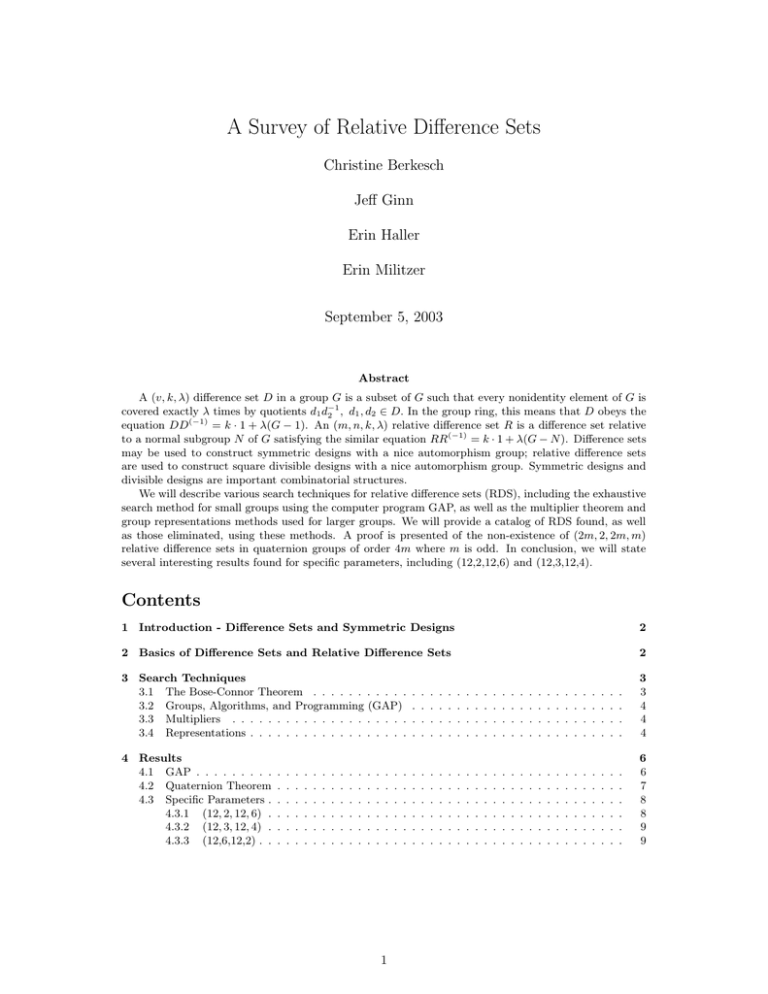
A Survey of Relative Difference Sets
Christine Berkesch
Jeff Ginn
Erin Haller
Erin Militzer
September 5, 2003
Abstract
A (v, k, λ) difference set D in a group G is a subset of G such that every nonidentity element of G is
covered exactly λ times by quotients d1 d−1
2 , d1 , d2 ∈ D. In the group ring, this means that D obeys the
equation DD (−1) = k · 1 + λ(G − 1). An (m, n, k, λ) relative difference set R is a difference set relative
to a normal subgroup N of G satisfying the similar equation RR(−1) = k · 1 + λ(G − N ). Difference sets
may be used to construct symmetric designs with a nice automorphism group; relative difference sets
are used to construct square divisible designs with a nice automorphism group. Symmetric designs and
divisible designs are important combinatorial structures.
We will describe various search techniques for relative difference sets (RDS), including the exhaustive
search method for small groups using the computer program GAP, as well as the multiplier theorem and
group representations methods used for larger groups. We will provide a catalog of RDS found, as well
as those eliminated, using these methods. A proof is presented of the non-existence of (2m, 2, 2m, m)
relative difference sets in quaternion groups of order 4m where m is odd. In conclusion, we will state
several interesting results found for specific parameters, including (12,2,12,6) and (12,3,12,4).
Contents
1 Introduction - Difference Sets and Symmetric Designs
2
2 Basics of Difference Sets and Relative Difference Sets
2
3 Search Techniques
3.1 The Bose-Connor Theorem . . . . . . . . . . .
3.2 Groups, Algorithms, and Programming (GAP)
3.3 Multipliers . . . . . . . . . . . . . . . . . . . .
3.4 Representations . . . . . . . . . . . . . . . . . .
.
.
.
.
.
.
.
.
.
.
.
.
.
.
.
.
.
.
.
.
.
.
.
.
.
.
.
.
.
.
.
.
.
.
.
.
.
.
.
.
.
.
.
.
.
.
.
.
.
.
.
.
.
.
.
.
.
.
.
.
.
.
.
.
.
.
.
.
.
.
.
.
.
.
.
.
.
.
.
.
.
.
.
.
.
.
.
.
.
.
.
.
.
.
.
.
3
3
4
4
4
4 Results
4.1 GAP . . . . . . . . .
4.2 Quaternion Theorem
4.3 Specific Parameters .
4.3.1 (12, 2, 12, 6) .
4.3.2 (12, 3, 12, 4) .
4.3.3 (12,6,12,2) . .
.
.
.
.
.
.
.
.
.
.
.
.
.
.
.
.
.
.
.
.
.
.
.
.
.
.
.
.
.
.
.
.
.
.
.
.
.
.
.
.
.
.
.
.
.
.
.
.
.
.
.
.
.
.
.
.
.
.
.
.
.
.
.
.
.
.
.
.
.
.
.
.
.
.
.
.
.
.
.
.
.
.
.
.
.
.
.
.
.
.
.
.
.
.
.
.
.
.
.
.
.
.
.
.
.
.
.
.
.
.
.
.
.
.
.
.
.
.
.
.
.
.
.
.
.
.
.
.
.
.
.
.
.
.
.
.
.
.
.
.
.
.
.
.
6
6
7
8
8
9
9
.
.
.
.
.
.
.
.
.
.
.
.
.
.
.
.
.
.
.
.
.
.
.
.
.
.
.
.
.
.
.
.
.
.
.
.
.
.
.
.
.
.
.
.
.
.
.
.
.
.
.
.
.
.
.
.
.
.
.
.
.
.
.
.
.
.
.
.
.
.
.
.
.
.
.
.
.
.
1
.
.
.
.
.
.
.
.
.
.
.
.
1
Introduction - Difference Sets and Symmetric Designs
An important topic in the field of discrete mathematics is the study of block designs. A (n, k, λ) block
design is a set of v points arranged into b blocks of size k where any 2 points are together on exactly λ
blocks. A design is called symmetric if v = b.
Symmetric designs may be constructed using difference sets. Given a difference set D in a group G,
define the points of the design as the elements of G and the blocks as the translates gD for g ∈ G of the
difference set. This construction gives a symmetric design with an automorphism group acting sharply
transitive on the points of the design ([3], p. 8-10).
A group divisible design is a combinatorial structure with a slightly weaker condition than a symmetric
block design ([3], p. 3). A group divisible design may be constructed from relative difference sets in the
same way that symmetric designs are constructed from difference sets.
Much of the research on RDS has focused on families of semiregular difference sets (see [3], p. 40).
This paper will survey small parameter sets for semiregular RDS and describe several semiregular RDS
which were previously unknown.
In this paper, we exhausively determine the existence of RDS with certain small parameters and find
new semiregular RDS.
Acknowledgements
This research was done during Summer 2002 at Central Michigan University under the guidance of Dr.
Ken Smith and sponsorship of the National Science Foundation Research Experience for Undergraduates
grant (NSF DMS-0097394).
2
Basics of Difference Sets and Relative Difference Sets
Throughout this paper, we use definitions and notation based on those of Alexander Pott [3].
Definition 1. A (v, k, λ) difference set D is a subset of a group G of order k such that in the list of
quotients d1 · d−1
2 with distinct elements d1 , d2 ∈ D each nonidentity element of G occurs exactly λ times.
Definition 2. An (m, n, k, λ) relative difference set R in a group G of order m · n relative to a forbidden
normal subgroup N (|N | = n) is a k-subset of G with the following property: the list of quotients r 1 · r2−1
with distinct elements r1 , r2−1 ∈ R contains each element in G/N exactly λ times and does not contain
the elements of N . Thus, the following formula in the group ring ZG must be satisfied:
RR(−1) = k · 1 + λ(G − N ).
Difference sets are homomorphic images of relative difference sets (RDS). One can show that the
existence of an (m, n, k, λ) relative difference set implies the existence of an (m, k, nλ) difference set.
Suppose a group G contains a relative difference set R relative to a normal subgroup N , then if a normal
subgroup H of G is contained in N , there exists a relative difference set in G/H relative to N/H.
Furthermore, if R has parameters (m, n, k, λ) then the RDS in G/H will have parameters (m, nh , k, λh)
where |H| = h. Hence, G/N will contain an (m, k, nλ) difference set which is said to be a contraction of
R. R is said to be an extension or lifting of this difference set. The contraction of a semiregular RDS is
the trivial (m, m, m) difference set.
The existence of a (v, k, λ) difference set implies the existence of a (v, k, λ) symmetric design. Similarly, the existence of an (m, n, k, λ) RDS implies the existence of an (m, n, k, λ) divisible design. (See
Section 1.1 of [3].)
Definition 3. An (m, n, k, λ) divisible design is an incidence structure with mn points and the same
number of blocks such that every block has k points and every point is on k blocks. Also, every pair of
points will be together on λ blocks except the points corresponding to the cosets of the normal subgroup
N to which the (m, n, k, λ) RDS is relative.
Let the elements of a group G form the points of a divisible design. The translates of a relative
difference set R in G form the set of blocks B of the design, so that B = {gR : g ∈ G}.
2
Divisible designs are often useful in projective geometries. If we are given a projective plane and
remove one of the blocks and all those parallel to it, we are left with a divisible design [?].
Lemma 1. Given a group G and a normal subgroup N of G, R may contain no two elements of the
same coset of N .
Proof. Let x ∈ G and N x be a right coset of N . Suppose r1 and r2 are distinct elements of R such that
r1 = n1 x and r2 = n2 x where n1 , n2 ∈ N . Then
−1
r1 r2−1 = (n1 x)x−1 n−1
2 = n1 n2 ∈ N,
but r1 r2−1 is not supposed to be in N , a contradiction. 2
Lemma 2. Given a group G with normal subgroup N and RDS R, then any translate Rg := {rg : r ∈ R}
of R is also a RDS.
Proof. If x = r1 r2−1 for r1 , r2 ∈ R then x = r1 (gg −1 )r2 = (r1 g)(r2 g)−1 and r1 g, r2 g ∈ Rg. 2
Definition 4. A relative difference set is said to be semiregular if m = k = nλ.
Theorem 1 (Prime powers in RDS). (pa , pb , pa , pa−b ) RDS exist whenever p is a prime and a ≥ b
[?].
3
Search Techniques
In this section we describe the various techniques we used to search for relative difference sets in finite
groups.
3.1
The Bose-Connor Theorem
Theorem 2 [3]. Let R be an (m, n, k, λ) RDS in a group G with respect to a subgroup N . If k 2 ≥ mnλ
and k > 0 then
(1) if m is even then k 2 − mnλ is a square. Moreover, if m ≡ 2 mod 4 and n is even, then k is the
sum of two squares.
(2) if m is odd and n is even then
(2a) k is a square and
(2b) the equation
(k 2 − mnλ)x2 + (−1)m(m−1)/2 nλy 2 = z 2
has nontrivial integer solutions (x, y, z).
(3) if both m and n are odd then the equation
kx2 + (−1)n(n−1)/2 ny 2 = z 2
has nontrivial integer solutions.
The Bose-Connor theorem is useful in ruling out RDS parameters. For example, there exist no
nontrivial integer solutions to the equation
10x2 + ((−1)5(5−1)/2 · 5)y 2 = z 2 ,
which corresponds with the (19, 5, 10, 1) parameter set, where m and n are both odd. This implies that
no (19, 5, 10, 1) RDS exists.
3
3.2
Groups, Algorithms, and Programming (GAP)
For groups of small order, an exhaustive search can be the most effective method for finding all possible
RDS. The computer program GAP [1] provides a complete listing of groups, along with the capability
to search them for RDS. By modifying a GAP program written by Dr. Ken Smith, it was possible to
search for RDS with various parameters, the results of which can be found in section 4.1.
The program checks all groups corresponding to a given set of parameters for a RDS. Within each
group G, it finds each normal subgroup N of the appropriate order and also generates the cosets with
respect to N. Each relative difference set has at most one element in a given coset of N , and so a RDS
R is a subset of a transversal (a system of coset representatives) of N . If the RDS is semiregular, then
it is equal to a transversal.
The GAP program chooses a transversal and checks to see if it provides a RDS. If not, it chooses
another transversal. There are nm transversals for a given subgroup N , but the search can be reduced
to nm−2 possibilities by fixing two elements of R: the identity element and one element x from another
coset. This is allowed by the following argument. Assume x 6∈ N. Then there exists r1 , r2 ∈ R such that
x = r1 r2−1 . Since R is a RDS, so is Rr2−1 . But since r1 , r2 ∈ R then x = r1 r2−1 and 1 = r2 r2−1 are in
Rr2−1 . Thus the RDS R can be replaced by the RDS Rr2−1 , which contains both 1 and x.
If the initial transversal choice fails, the elements in the cosets are permuted until a RDS is found
or all possibilities have been exhausted. The problem, however, is that as the order of the group grows
and the number of groups of the orders grow, the number of possibilities for transversals increases
exponentially. For this reason, the exhaustive method should only be used for small groups. For larger
groups, other methods had to be implemented. Exhaustively searching a group for an (m, n, k, λ) RDS
required checking nm−2 putative difference sets to see if they satisfied the basic equation from definifion
2. If nm−2 was on the order of a million, this process took several hours on a Mac G3 laptop computer.
3.3
Multipliers
Lemma 3. If A is an Abelian group written in additive notation and t is relatively prime to the order
of A, then a 7→ ta for all a ∈ A is an automorphism of A.
Definition 5. If tD = g + D for some g ∈ G, then t is said to be a multiplier.
Conjecture. Suppose t is relatively prime to the order of A and, in addition, t|(k − λ) in a difference
set or if t|(k 2 − mnλ) in a RDS. Then, if there exists a (v, k, λ) difference set or an (m, n, k, λ) RDS then
there is a difference set or RDS fixed by t (see [3], pp. 29-30).
Suppose we are searching for a (7, 4, 2) difference set in Z7 ; then t = 2 is a multiplier. The multiplier
t = 2 generates the orbits {0}, {1, 2, 4}, {3, 5, 6} in {Z7 , +}. We pick {0} and one of {1, 2, 4} or {3, 5, 6}
to be our difference set. Note that the sets {0, 1, 2, 4} and {0, 3, 5, 6} are isomorphic to one another under
a 7→ 3a.
A multiplier may also be “lifted.” If we were to lift the (7, 4, 2) difference set from the above example
into a (7, 2, 4, 2) RDS, then the multiplier t = 2 would be lifted to t = 9 where a 7→ 9a is an automorphism
of Z14 and fixes a (7, 2, 4, 2) RDS.
3.4
Representations
A representation Φ of a group G is an operation-preserving map from (G, ∗) into (GL n (C), ·). Representations will be used to distinguish between the elements in each coset while building a RDS.
A representation Φ is said to be trivial on a subgroup N of G if Φ(x) = 1 for all x ∈ N.
Representations of finite groups may be built from a special set of representations called “irreducible
representations” (see [?]). We extend a representation Φ on G to a representation of the group ring ZG
P
P
by defining Φ( ag g) :=
ag Φ(g). Thus, Φ : ZG → MatN (C) is an algebra homomorphism.
Theorem 3. Let N be a normal subgroup of G; let Φ be an irreducible representation of G. Then
X
either Φ is trivial on N or
Φ(x) = 0.
x∈G
4
In the case where Φ(N ) is trivial on N , each element in a coset of N is treated the same. This only
reiterates the fact that one element must be chosen from each coset without providing new information
to aid in the actual selection of elements. Thus for the given purposes, the cases of interest occur when
P
see [?] and [?].)
x∈G Φ(x) = 0. (For further reading and examples on this topic,
P
P
When Φ is not trivial on N , it should be noted that both g∈G Φ(g) and n∈N Φ(n) = 0, and so
Φ(G − N ) = 0.
Example:
Search for an (8,2,8,4) RDS in the group G = Q8 =< x, y : x8 = y 4 = 1, yxy −1 = x−1 , x4 = y 2 >
with respect to the unique subgroup of order two: N = {1, x4 }. Let ζ be a primitive 8th root of unity.
Here are the representations of G and their action on N .
Representations
Φ1
Φ2
x
1
-1
µ
¶
ζ 0
µ 02 ζ̄ ¶
ζ
0
2
0
ζ̄
¶
µ 3
ζ
0
3
0 ζ̄
y
±1
µ ±1 ¶
0
1
−1
0¶
µ
0
1
µ −1 0¶
0
1
−1 0
N
2
2
µ
¶
0 0
µ 0 0¶
2 0
µ 0 2¶
0 0
0 0
Since Φ1 and Φ2 are the only cases which are non-trivial on N,
considered.
¶
µ
¶ µ
µ
8
0 0
0 0
]=
For Φ1 and Φ2 , RR(−1) 7→ 8I2 + 4[
0
0 0
0 0
trivial on N
trivial on N
trivial on N
they are the only two that need to be
0
8
¶
First, let us consider Φ1 . The cosets with respect to N are:
1
x4
x
x5
x2
x6
x3
x7
y
x4 y
These elements map as follows under Φ1 :
¶
µ
1 0
0 1
¶
µ
ζ 0
0 ζ̄
µ 2
¶
ζ
0
2
0 ζ̄
¶
µ 3
ζ
0
0 ζ̄ 3
¶
µ
0
1
−1 0
µ
¶
0
ζ
−ζ̄ 0
¶
µ
0
ζ2
−ζ̄ 2 0
¶
µ
0
ζ3
−ζ̄ 3 0
µ
¶
−1
0
0
−1
¶
µ
−ζ
0
0
−ζ̄
µ 2
¶
−ζ
0
2
0
−ζ̄
5
xy
x5 y
x2 y
x6 y
x3 y
x7 y
−ζ 3
0
0
−ζ̄ 3
¶
µ
0 −1
1
0
µ
¶
0 −ζ
ζ̄
0
µ
¶
0 −ζ 2
2
ζ̄
0
µ
¶
0 −ζ 3
3
ζ̄
0
µ
¶
¶
¶
µ
a b
ā c̄
(−1)
, where a = ²0 + ²1 ζ + ²2 ζ 2 + ²3 ζ 3 and b = ²4 + ²5 ζ +
Let R 7→
and R
7→
b̄ d¯
c d
²6 ζ 2 + ²7 ζ 3 . Here ²i = ±1, where 1 indicates the element from top row of a coset and -1 indicates
the element from bottom row of a coset. The elements c and d follow from the values of a and b.
µ
¶ µ
¶
aā + bb̄ ac̄ + bd¯
8 0
(−1)
Therefore, RR
7→
=
.
cā + db̄ cc̄ + dd¯
0 8
µ
In other words, ||a||2 + ||b||2 = 8 and cā + db̄ = 0.
One solution to these equations is ²i = (1, 1, 1, 1, 1, 1, −1, 1), i.e. all of the elements for the
relative difference set are from the top row in the cosets except for the second to last one.
√
√
Using these choices, a = 1 + ( 2 + 1)i and b = 1 + ( 2 − 1)i.
√
√
So ||a||2 = 4 + 2 2, ||b||2 = 4 − 2 2, and ||a||2 + ||b||2 = 8, as desired.
By working back through the mappings, we find that R = 1 + x + x2 + x3 + y + xy + x3 y + x6 y
is an (8, 2, 8, 4) RDS in Q8 .
4
4.1
Results
GAP
The following tables describe the results of an exhaustive search in GAP, grouped according to
the type of relative difference set. In each table we list parameters of relative difference sets
and determine the existence of a RDS with those parameters. If we found the difference sets
using GAP in an exhaustive search, we included, for each group with a RDS, the number of
the group in GAP’s small group library. For example, “16.2,3,4,5,9,10,11,12,13” in the “GAP
library number” column in the first table indicates that of the fourteen groups of order sixteen,
the groups numbered 2-5 and 9-13 have (8, 2, 8, 4) relative difference sets.
(m, 2, m, m/2)
Parameters
(6,2,6,3)
(8,2,8,4)
(10,2,10,5)
(12,2,12,6)
(14,2,14,7)
RDS?
no
yes
no
yes
no
GAP library number
16.2, 3, 4, 5, 9, 10, 11, 12, 13
24.3, 4, 11
(m, m, m, 1)
6
Parameters
(4,4,4,1)
(5,5,5,1)
(6,6,6,1)
(7,7,7,1)
(8,8,8,1)
RDS?
yes
yes
no
yes*
yes*
GAP library number
16.2, 6, 12
25.2
*These exist by Theorem 1. No further search was performed.
Other
Parameters
(8,2,8,4)
(8,4,8,2)
(9,3,9,3)
4.2
RDS?
yes
yes
yes
GAP library number
16.2, 3, 4, 5, 9, 10, 11, 12, 13
32.21, 23, 25, 26, 28, 29, 32, 33, 35
27.2, 3, 4, 5
Quaternion Theorem
The quaternion groups, Q2m =< x, y : x2m = y 4 = 1, yxy −1 = x−1 , xm = y 2 >, are a particularly
interesting case for the (2m, 2, 2m, m) parameters. We found the following when considering these
groups:
Parameters
(4,2,4,2)
(6,2,6,3)
(8,2,8,4)
(10,2,10,5)
(12,2,12,6)
(14,2,14,7)
(16,2,16,8)
(18,2,18,9)
(20,2,20,10)
(22,2,22,11)
(24,2,24,12)
RDS?
Yes
No
Yes
No
Yes
No
Yes
No
Yes
No
Yes
Reason
Exhaustive search (GAP)
Exhaustive search (GAP)
Bose-Connor Theorem
Exhaustive search (GAP)
Bose-Connor Theorem
There is an obvious pattern in the existence of a RDS when m is even and nonexistence when
m is odd. With this in mind, the following theorem arose.
Theorem 4. There do not exist any (2m, 2, 2m, m) RDS in Q2m when m is odd.
Proof. For (2s, 2, 2s, s) RDS in Q2s when s is odd, check two representations:
Φ1 : x 7→ −1, y 7→ i.
µ
¶
µ
ζ 0
0
Φ2 : x 7→
, y 7→
0 ζ̄
−1
¶
1
,
0
where ζ is a primitive 2sth root of unity.
By constructing R from the cosets of Q2m with respect to N , it is obvious that
R=
s−1
X
ai x i + (
i=0
s−1
X
i=0
Therefore, RR(−1) = 2s · 1 + λ(0) = 2s · 1.
7
bi xi )y.
s−1
X
ai ζ i
i=0
For Φ2 , R 7→
0
s−1
X
bi ζ i
0
+ i=0
s−1
X
i
0
ai ζ̄
i=0
0
s−1
X
i=0
bi ζ̄
y,
i
¶
¶µ
¶ µ
0 1
B 0
0
,
+
=
−1 0
0 B̄
Ā
¶
µ
A B
.
=
−B̄ Ā
µ
¶
AĀ + B B̄
0
(−1)
So, RR
7→
.
0
AĀ + B B̄
µ
A
0
Therefore AĀ + B B̄ = 2s ∈ (2) but ∈
/ (4).
By (2) and (4), we mean the ideals generated by 2 and 4, respectively. While A and B
are cyclotomic integers, the given statement still holds. For further reading on this topic, consult
Ireland and Rosen [?].
Now, A =
s−1
X
i=0
ai ζ i , where ai = ±1, the indicator within each coset.
s−1
X
A+0=
s−1
X
ai ζ i +
=
s−1
X
(ai + (−1)i )ζ i .
(−1)i ζ i ,
i=0
i=0
i=0
⇒ A ∈ (2) and similarly, B ∈ (2).
⇒ Since (2)(2) = (4), we have that AĀ + B B̄ ∈ (4), a contradiction. 2
This leaves the cases with m even open. We have not yet been able to prove the existence of
a (2m, 2, 2m, m) RDS in this case, but do believe it is true. We conjecture that there exists a
(2m, 2, 2m, m) RDS in all Q2m when m is even.
After reaching this conclusion, we found Ito’s conjecture, which states that there are (4t, 2, 4t, 2t)
RDS in Q8t for all t such that 2t − 1 or 4t − 1 is a prime power [?]. This conjecture is strong and
has been verified for all t ≤ 46 [2]. It is important to point out that a proof for this conjecture
would also imply the Hadamard conjecture, which has remained open since posed in 1893.
4.3
4.3.1
Specific Parameters
(12, 2, 12, 6)
It is worth noting that we found only three (12, 2, 12, 6) RDS, all in nonabelian groups: SL 2 (3),
Q12 , and Z3 × Q4 , which are all generated by three elements, x, y, z such that:
SL2 (3) = < x, y, z : x4 = y 4 = z 3 = 1, x2 = y 2 , yxy −1 = x−1 , zxz −1 = y, zyz −1 = xy >,
Q12 = < x, y, z : x4 = y 4 = z 3 = 1, x2 = y 2 , yxy −1 = x−1 , xzx−1 = z 2 , yz = zy >, and
Q4 × Z3 = < x, y, z : x4 = y 4 = z 3 = 1, x2 = y 2 , yxy −1 = x−1 , xz = zx, yz = zy >.
This points out that investigating RDS in only Abelian groups will not give a full analysis of
all working parameters. Nonabelian groups contain RDS that are also quite interesting.
A (12, 2, 12, 6) relative difference set in all three groups is:
R = (x2 + x + y + xy)(1 + z) + (1 + x + y + xy)(x2 z 2 ).
The idea that one “magic” formula will produce a RDS in all three groups is exciting. It
suggests that all other RDS should be investigated to see if this phenomenon occurs with any
other parameters.
8
4.3.2
(12, 3, 12, 4)
Alexander Pott stated, “(m, 2, m, m/2) are the only examples of semiregular relative difference
sets in groups which are not p-groups: All known examples with n 6= 2 live in p-groups” [3], p.
103.
However, we found (12, 3, 12, 4) RDS in the three following groups: Q6 × Z3 , A4 × Z3 , and
(Z6 × Z2 ) × Z3 . These groups provide examples outside p-groups which do contain RDS. This
opens the door to a search for many other RDS. Notice also that all three groups are splitting,
meaning that Z3 = N in each group.
A (12, 3, 12, 4) RDS in Q6 × Z3 = < x, y, z : x6 = y 4 = 1, yxy −1 = x−1 , x3 = y 2 , z 3 = 1, zx =
xz, zy = yz > is:
(1 + y + x2 y + x4 y + x5 + xy) + (x3 + x3 y + x2 + x5 y)z + (x4 + x)z 2 .
A (12, 3, 12, 4) RDS in A4 × Z3 =< x, y1 , y2 : x3 = y12 = y22 = 1, y2 = y1x , y2x = y1 y2 > × < z :
z 3 = 1 > is:
(1 + x2 y1 + xy1 + xy2 + y2 + x2 ) + (y1 + x2 y1 y2 + y1 y2 + x2 y2 )z + (xy1 y2 + x)z 2 .
A (12, 3, 12, 4) RDS in (Z6 × Z2 ) × Z3 =< x, y, z : x6 = y 2 = z 3 > is:
(1 + x2 y + x3 + x5 ) + (x + xy)z + (y + x2 + x3 y + x4 + x4 y + x5 y)z 2 .
4.3.3
(12,6,12,2)
The next logical step is to attempt a lift of the previous two parameters to a (12, 6, 12, 2) RDS.
In order to be eligible for such a RDS, a group G of order 72 must have a normal subgroup N of
order six where the subgroups H2 and H3 of N , of orders two and three respectively, give factor
groups corresponding to those which have (12, 3, 12, 4) and (12, 2, 12, 6) RDS.
Using GAP, it was determined that the possibility of such a RDS only exists in two groups:
SL2 (3) × Z3 and Q4 × Z32 .
An exhaustive search of these groups, using GAP, would require, for each normal subgroup N
of order six, examining 610 ≈ 60 million transversals and running a relative difference set check
on each transversal. Our current program would take approximately a month of computer time
to exhaust one group. Therefore, at this time, the existence of a (12, 6, 12, 2) RDS is still open.
9
References
[1] The GAP Group, GAP — Groups, Algorithms, and Programming, Version 4.2;2002.
(¡http://www.gap-system.org¿)
[2] B. Schmidt, Williamson Matrices and a Conjecture of Ito’s, Designs, Codes, and Cryptography, Vol. 17 (1999) pp. 61-68.
[3] A. Pott, Finite Geometry and Character Theory, Springer-Verlag, Berlin-Heidelberg 1995.
10
